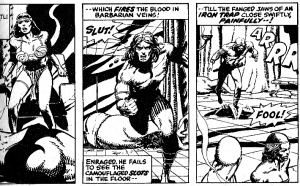 For me, dungeon traps are an unsolved problem in 4e. I’d like something between a full-fledged 4e skill-challenge trap and the old-school spanking for not tapping every flagstone with a ten-foot pole. I’ve made attempts to solve the problem, but I haven’t been happy with any of them. (My favorite so far is the Mazes and Monsters rule: the Maze Controller cannot spring a trap unless he has announced that it “could be a trap”.)
For me, dungeon traps are an unsolved problem in 4e. I’d like something between a full-fledged 4e skill-challenge trap and the old-school spanking for not tapping every flagstone with a ten-foot pole. I’ve made attempts to solve the problem, but I haven’t been happy with any of them. (My favorite so far is the Mazes and Monsters rule: the Maze Controller cannot spring a trap unless he has announced that it “could be a trap”.)
The above panels from “Red Nails” in the 1970’s Savage Sword of Conan comic gave me an idea. Conan would TOTALLY have spotted that bear trap if he hadn’t been raging – and running.
How about this rule: Under normal circumstances, all PCs spot all adjacent traps – no Perception check required.
PCs only fail to notice traps when they’re running or charging (and maybe also a handful of other distracting conditions: dazed, stunned, or blinded).
With this rule, traps are most dangerous in combat, and in very specific circumstances like chases: in other words, they add danger to already dangerous scenes, instead of slowing down routine situations. It’s the DM’s job, as the roleplayer of the ancient dungeon architect and the kobold snaremaster, to put traps in places where PCs will be tempted to rush heedlessly.








Also I see Conan is once again consulting the random harlots table.
Is Conan calling the woman a slut or is he responding to someone also doing so? I don’t think it is appropriate for Conan to call a woman a slut.
What is best in life? To crush your enemies, see them driven before you, and to use language that contributes to a hostile workplace.
Also, in the previous panel (not shown), Conan is saying, “JANE YOU IGNORANT”
Original D&D, volume 3, page 8:
“Thus it takes ten minutes to move about two moves — 120 feet for a fullyarmored
character.”
That’s 12 feet per minute. The baseline assumption is that you’re already being careful.
So to not see a trap, it would have to be exceptionally well hidden. The only type of referee who would use traps like that would, of course, be a total bastard.
Heh heh heh…
So it sounds like what you’re saying is (if I may word it like a rule):
“Player characters easily notice trapped squares before entering them, unless the player is granting Combat Advantage.”
I’ve been thinking about traps, and I agree that they’re kind of lacking in 4e. I was actually thinking of writing up a post on it, but I think it basically boils down a matter of categories. In D&D, you really have three kinds of traps: “Traps”, “Tricks”, and “Hazards”.
Traps: Your conventional “attacking you out of nowhere” devices. These are generally not very interesting if players just happen up on it while walking down a hallway, but when used out of combat they can work to create atmosphere and foreshadow later dangers. Maybe the players run across something that zaps them for lightning damage, or acid oozes out of the wall, or gouts of fire from the floor — all foreshadowing more obvious hazards later in the dungeon. These work best as one-shot attacks that peel off a healing surge or two from the party to add some challenge to the dungeon. They’re equivalent to about a single monster.
Tricks: These are more obvious, puzzle-like encounters that the players notice, but which still may be tricky to circumvent. They can include a specific damaging trap, or an ongoing hazard, and generally provide a good opportunity for skill challenges. They can surprise the players, but they are still a challenge to get past once they’re discovered. These are more like a full encounter.
Hazards: Standard combat hazards. Obvious, and very dangerous. Sometimes they can be tied to a combat encounter, but they can just as easily be part of the scenery.
In general, my rule of thumb has been that a trap can be either Quick, Deadly, or Hidden — but not all three at once. A deadly trap that kills instantly is not very fun striking out of the blue, but works well if you telegraph its properties well in advance. Likewise, you can hide a very dangerous trap and spring it only on the players out of nowhere when the time is right; but if you do that, make it into a multi-round encounter to escape.
Tomb of Horrors has good examples of both of these, but i don’t want to spoil anything
Conan? …APPROPRIATE? He once killed an unarmed old man ( a judge, true ) because he didn’t like what the old man said. (Queen of the Black Coast)
Killing an unarmed old man is totally appropriate, actually, considering the kind of arrogant impulsive guy Conan is. But, Jesus, if there’s anyone who would appreciate a sexually liberated woman, I think it is Conan the Barbarian. I’ve never known Conan to be a slut shamer!